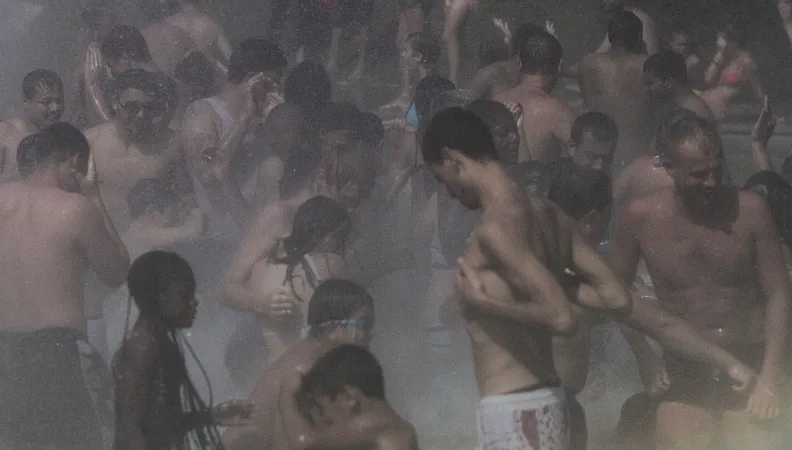Share the page
How to Cool Cities in Hot Weather
Published on

As a result of climate change, heatwaves are increasing all over the world. This presents a challenge for cities, which must adapt to these periods of intense heat. Measures for dealing with the climate crisis in urban areas were presented at COP26 earlier this month.
High temperatures are typically deadlier in cities. During the 2003 heatwave in France, the rate of excess mortality was 40% in small and medium-sized towns. In large cities such as Paris, that rate jumped to 141%. And with climate change, the gap has widened. That same summer, Paris was 10°C higher than in rural areas, compared to a difference of just one degree in 1868.
Uninhabitable cities
Among the cities are on the verge of becoming uninhabitable for humans are Jacobabad in Pakistan, and Ras Al Khaimah in the Persian Gulf. Temperatures can exceed 35°C for several consecutive days, with a humidity level of close to 90%. Under such conditions, the human body struggles to cope.
Last March, the Arabian Peninsula reached temperatures of over 40 degrees, usually a level of heat not seen before June. Abu Dhabi in the UAE and Shanghai, China, are among the most vulnerable to extreme heat, and Jakarta, Indonesia is reported to be the fastest-sinking city in the world. No continent is spared by climate change: summer temperatures in Buenos Aires are rising faster than the global average.
In an effort to cope with the increasing threat of overheating and submerged cities, cooling measures being implemented worldwide were presented at COP26 earlier this month, with the support of AFD. “We have produced a guide, the result of a collaboration between AFD and ADEME, the French Agency for Ecological Transition,” says Samuel Lefèvre, AFD’s city and climate expert. “This publication is a compilation of feedback: in recent years, to increase their resilience to heat, certain cities around the world have been trialling various types of urban development.”
View the guide “Urban cooling solutions”
Several projects, some of which have been financed by AFD, propose different measures for coping with climate change in line with the implementation of the Paris Agreement on climate change.
In the new city of Zenata, in Morocco, thermodynamic studies have been conducted to identify the direction of prevailing winds in order to naturally ventilate the city. The cooling effects of several potential urban shapes and networks were simulated, as well as the so-called “aeraulic networks”. Zenata can thus benefit from its position with an opening to the sea, the dominance of cool winds from the north, and the mountains to the east, to naturally cool the city.
In addition to the formation of heat islands, there is also a risk of flooding. To help prevent this, many green spaces have been created in Zenata to absorb water. These vegetated areas cover 470 hectares of the city, i.e. one third of the land area. Many adaptations have been made with the financial support of AFD and the city hopes to be recognized as an “eco-city” by 2030.
In the commune of La Possession, in the north-west of Reunion Island, the aim is to make the “Cœur de ville” Urban Development Zone (ZAC) a “garden city” to provide natural cooling. Faced with the risks of cyclones, floods and extreme heatwaves, the district’s surface land has been designed to maximize soil permeability. Outside of the vegetated areas, 50% of the soil is permeable. Landscaped channels have also been created to store rainwater and direct it naturally to drains. The goal is to avoid the use of pipes and to encourage what is called "evapotranspiration" - a process of evaporation from the land surface plus transpiration from plants.
To limit the use of air conditioning, the layout of the streets and buildings has been very carefully thought out, with the installation of innovations such as sunshade devices, to reduce exposure to solar radiation. In 2013, AFD granted a €14 million loan to finance two development concessions in La Réunion, including the “Cœur de Ville” ZAC.
In Brazil, the Barigüi riverbank development project aims to manage flood risks and create green public spaces, in line with its approach to protect biodiversity in the city. Urban cooling appears to be a co-benefit of this kind of development.
Planting vegetation to stabilize riverbanks, for instance, increases shade and promotes evapotranspiration. Only endemic and non-invasive species have been planted, so the vegetation on the banks stabilizes the soil and minimizes erosion. The surface area of green space per inhabitant in Curitiba is 64.5 m² compared to the recommendation by the World Health Organization (WHO) of 10 m² per inhabitant. AFD awarded close to €36 million to complete this project in 2011.
Fighting climate change and mitigating its effects
These projects are sometimes based on quite ancient practices, according to Samuel Lefèvre: “We are rediscovering ways of designing urban spaces – such as making the most of shade and wind direction, and installing light-colored roofs to reflect rather than absorb the sun's rays – which have been around for a very long time.” This issue is becoming more critical as urban populations continue to grow, with access to employment being a key factor. “In 2030, an estimated 60% of the world’s population will be living in cities,” says AFD's city and climate expert.
See also: 5 pioneering cities on the climate
These measures for coping with heatwaves in cities can also reduce the production of greenhouse gases insofar as they limit the use of air conditioning, an increasingly common solution among city dwellers. However, they do not help to resolve the climate issue. “It is not just a question of managing the consequences of climate change, but also of addressing the underlying causes,” says Samuel Lefèvre. While these are certainly palliative solutions, they are also now essential for humankind.
